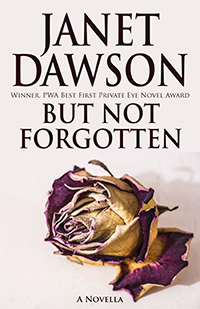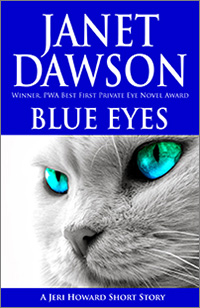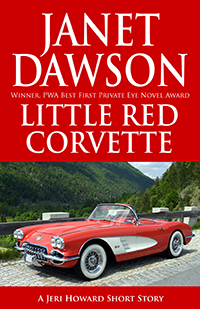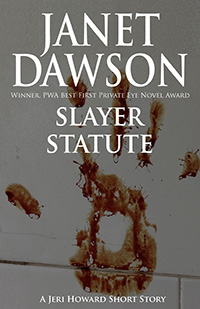 Novella: “But Not Forgotten”
Novella: “But Not Forgotten”
It’s been 50 years since Fern Chatfield disappeared. What happened to her?
Did she run away? Or was she abducted?
Maggie Constable wants to know how the story ends.
A warm June evening. A high school graduation party. Fern ends her relationship with her boyfriend Hank. He doesn’t take it well. In fact, he tries to hit her. But Fern’s best friend Maggie intervenes.
After Hank stalks off into the darkness, Fern says she’s going to walk home.
But she never gets there.
Fifty years have gone by. Maggie’s a tough-minded veteran reporter, accustomed to pursuing the truth. This story has haunted her for years. She goes to her 50th high school reunion, determined to find out, once and for all, what happened to Fern.
Read an excerpt from “But Not Forgotten”
Short stories, we’ve got short stories! Now available for Kindle, twelve of Janet’s short stories:
 “Blue Eyes”: The late Mrs. Littlejohn left a large sum of money for the care and feeding of her cat. But something about that will is fishy, as Jeri Howard discovers. Buy it for Kindle
“Blue Eyes”: The late Mrs. Littlejohn left a large sum of money for the care and feeding of her cat. But something about that will is fishy, as Jeri Howard discovers. Buy it for Kindle
“By the Book”: Accident? Or suicide? That’s the question Navy Lieutenant Dinah Gray must answer when a sailor at her Navy command drives a car into San Francisco Bay. Dinah discovers a lot of people would rather she didn’t make waves. Despite the pressure, the young officer must go where the evidence, and her conscience, lead her. Buy it for Kindle
“Candles on the Corner”: Twelve-year-old Emily Gebhardt is dead—struck down by a hit-and-run driver while walking home from school. The makeshift shrine of candles and flowers on the corner is a daily reminder of her parents’ pain and loss. It’s also a starting point for investigation as PI Jeri Howard searches for information to bring the perpetrator to justice. Justice – that’s what Emily’s parents want. Or is it vengeance? Buy it for Kindle
“Invisible Time”: Greta and Hank are orphaned and homeless, scrabbling for survival on the cold, rainy streets of San Francisco. In this noir take on Hansel and Gretel, the little girl struggles to keep herself and her brother from falling through the cracks in this scary urban landscape, where homeless adults help and also prey on lost children. Buy it for Kindle
 “Little Red Corvette”: Why was the vintage Corvette abandoned at a repair shop? Jeri Howard looks into the car’s provenance, and finds murder. Buy it for Kindle
“Little Red Corvette”: Why was the vintage Corvette abandoned at a repair shop? Jeri Howard looks into the car’s provenance, and finds murder. Buy it for Kindle
“Mrs. Lincoln’s Dilemma”: Mary Todd Lincoln, wife of the sixteenth president, is the First Lady of a nation embroiled in the Civil War. She’s also a savvy political wife in wartime Washington. In this story, the First Lady uses her powers of observation and the help of two White House employees to sort out crimes—including murder—and bring the perpetrators to justice. Buy it for Kindle
“Pack Rat”: A pack rat—of the human variety—lives in the rundown house, surrounded by the junk he hoards. As the officers discover, there’s more to this short story than the rats at the window and the piles of old newspaper inside. What’s going on is a crime. Buy it for Kindle
“Scam and Eggs”: A fabulous jeweled egg made by Fabergé for the Russian imperial family disappears during an art gallery opening. Does the gallery owner have something to do with the crime? He’s had thefts from his other galleries, a pattern that retired private investigator Errol Seville believes is part of a scam to defraud the insurance company. The scam turns bloody when murder enters the picture. Buy it for Kindle
 “Slayer Statute”: Who gets the insurance money? That’s the tangled case Jeri Howard must unravel when a husband and wife die in what looks like a murder-suicide. Read an excerpt, and buy it for Kindle
“Slayer Statute”: Who gets the insurance money? That’s the tangled case Jeri Howard must unravel when a husband and wife die in what looks like a murder-suicide. Read an excerpt, and buy it for Kindle
“Voice Mail”: Winner of the Macavity Award for Best Short Story. The way we communicate now—by e-mail, text messages, voice mail—all detached and at a distance, without the immediate feedback of a face-to-face conversation, or even the voice-to-voice exchange of a phone call. But sometimes there are reasons for that distance, as one woman discovers when she uses voice mail to communicate her hostility to her soon-to-be ex-husband. It seems he has an agenda of his own. Buy it for Kindle
“What the Cat Dragged In”: Hattie Ballew is a gold miner in California’s Mother Lode. She works a claim with her brothers, and enjoys the company of her cat Little Bit, who pilfers things from the cabin and the surrounding woods. As Hattie finds out, the lust for gold leads to violence—and murder. And Little Bit may drag in a clue. Buy it for Kindle
“Witchcraft”: Backing the wrong horse can be murder. And jockey Deakin Kelley is about to be taken for the ride of his life. Deakin’s bewitched. He’s fallen under the spell of a beautiful woman, one with a sleek figure and a sly, come-hither smile. But witchcraft—and obsessive love—are dangerous. Buy it for Kindle
Casebook
Also available is Casebook. Together in one volume—four short stories featuring Jeri Howard: “Slayer Statute,” “Blue Eyes,” “Candles on the Corner” and “Little Red Corvette.” Buy it for Kindle.
Excerpts
Here is an excerpt from “But Not Forgotten”:
GONE, BUT NOT FORGOTTEN.
The words spanned the top of the poster on an easel near the front door. Beneath the legend were photographs, twenty-one in all. Like the name tag I wore, the photos were taken from the yearbook and showed how we looked fifty years ago, the year we graduated from Willow Creek High School. Under each picture was a classmate’s name. Twenty of those had a date and cause of death. The earlier deaths, all male, were mostly accidents—a head-on collision, a fall while hiking. The one exception was a classmate who’d been killed in action in Vietnam. In the past ten years, death had taken an equal opportunity toll among men and women, cancer and heart attacks, mostly.
The twenty-first photograph was labeled with a name, Fern Chatfield, and a date—graduation day. It was followed by a question mark. A fifty-year-old question mark.
I moved away from the poster as a man and a woman approached. The man’s name tag told me he was Curtis Lockwood. He didn’t look like his senior picture any more. After five decades, none of us did. He had been on the basketball team all those years ago. I recalled that younger boy as tall and skinny. Over the years his hair had thinned and he’d gained a pot belly and jowls, as well as a few scars and bags under his eyes. The woman next to him, his wife, presumably, looked vaguely familiar. Then I remembered. She had been a junior while we were seniors.
“Seems a bit strange to see Fern’s name up there,” he said.
She shrugged. “Where else would it be? I mean, Fern’s dead, right? She must be.”
“Some people say she ran off. Though I suppose she could be dead. There’s the bar. I could use a beer.” They moved away.
Fern must be dead. Or was she still alive, out there somewhere?
I gazed at her photo, sipping my wine. Then I glanced down at my own tag, reading my name upside down. Maggie Constable. And no, my senior picture didn’t look like me, either. My dark hair was turning silver at the temples. I had extra pounds, wrinkles, arthritis and other issues of age.
Belinda Wellfleet, one of the organizers of this fiftieth high school reunion, looked up from the nearby counter. She was checking in new arrivals, handing them their name tags and a souvenir booklet. For now there was a lull. She glanced at the poster, then at me, picking up on my thoughts. “Do you ever wonder what happened to Fern?”
“Of course. All the time.”
Well, not every waking hour. But often. For me, it’s the defining mystery, the one that’s never been solved—yet.
Fern was my best friend. She disappeared the night of our high school graduation party. She’d walked away from the building, through the parking lot to the street, then she turned, waving at me from the pool of light under a street lamp. I never saw her again.
Here is an excerpt from “Slayer Statute”:
“Why would one shoot the other?” I asked. I like to know why things happen.
Wilcoxin shrugged. “Don’t know, don’t care. They’re both dead. All I care about is who gets the money.” He frowned, as though considering how callous that sounded. “That’s for damn sure all the beneficiaries care about.”
“How much money?”
The insurance adjuster gazed morosely at the folder sitting like a toad in the middle of his desk. He named an amount certain to gladden the heart of any beneficiary, then appended a caveat.
“Payment to the beneficiaries is my top priority, but I want to be sure the insurance company hasn’t been defrauded. That’s where you come in, Ms. Howard. You were recommended to me as someone who can untangle messes. This case has been a monumental headache.”
I wasn’t sure I wanted to jump into this briar patch. “Tell me more. Then I’ll tell you if I’ll take it.”
Judging from the look on his face, the thought that I might not be willing to take on his headache evidently hadn’t occurred to Wilcoxin. He reached for the file, which concerned a husband and wife, both of them very dead. In fact, one of them had apparently committed homicide before committing suicide. Why? That was just one of the questions I had about the late Claude and Martha Terrell.
Late fifties, both of them. Late residents of Alameda, the island city in San Francisco Bay. They’d both been in real estate. Claude developed commercial, Martha sold residential. Having made piles of money, they both retired. Claude played golf, Martha played bridge—when she wasn’t collecting old silver.
The Terrells married eight years earlier, a second marriage for both, after their first matrimonial forays ended in divorce. Each had two adult children. Claude’s son Eric was thirty-one and married. Daughter Erin was twenty-nine and single. Martha’s daughter Pamela was thirty, married, with one child. Son Colin was twenty-seven and unmarried.
Not long after their wedding, the Terrells had purchased life insurance policies with Wilcoxin’s company. The policies had included the standard suicide clause, designed to discourage people from promptly killing themselves to benefit their families. The clause stated that if the insured committed suicide within two years after the policy issue date, the insurance company’s liability was limited to a return of the premiums paid. The suicide clause on the Terrell policy was no longer in effect. The insurer was now obligated to pay the beneficiaries, whom the Terrells had designated in what should have been a straightforward, logical fashion.
Should have been, that is, until words like homicide and suicide entered the equation.
“You’re familiar with the Slayer Statute?” Wilcoxin asked.
“California Probate Code Section 250? Indeed I am.”
“The medical examiner can’t say who died first. The police can’t figure out which one killed the other. You see my problem?”
“Indeed I do.” And it was a doozy.
The California Slayer Statute says that a person who “feloniously and intentionally kills the decedent” is not entitled to any of the decedent’s property, interest, or benefit, which then goes to the heirs “as if the killer had predeceased the decedent.”
So what did the Slayer Statute have to do with the Terrells’ life insurance policies? Everything.
Under normal circumstances, if Claude died first, the money from his insurance policy went to his primary beneficiary, Martha. If Martha was no longer living at the time Claude died, the payout went to his secondary beneficiaries, Claude’s two children, Eric and Erin. If Martha died first, the money from her insurance policy went to her primary beneficiary, Claude. If he was no longer living when Martha died, the payout went to Martha’s secondary beneficiaries, her children, Pamela and Colin, then to her tertiary beneficiary, Pamela’s young daughter.
But if the deaths were murder-suicide, normal went out the window. The law assumed the killer died first. So when it came to distributing the estate, the scenario went like this:
If Claude killed Martha, then turned the gun on himself, the law figured Claude died first and Martha was his beneficiary. Since Martha was also dead, her beneficiaries would get the money from Claude’s life insurance policy—plus the payout from Martha’s life insurance policy. And if Martha killed Claude, then herself, the law said she died first and Claude inherited. So Claude’s beneficiaries would get the money from Martha’s insurance—and Claude’s insurance money, too.
It was a lot of money. No wonder the beneficiaries were fighting. The winners got all the slices in the big, juicy pie.
“Why don’t these people just split the money four ways?” I asked.
Wilcoxin’s pained expression told me I didn’t know all the nuances of the insurance biz. Maybe not, but I knew about greed.
“It’s not that simple.”
I smiled. “No, I suppose not. It never is, where money is involved.”
“There’s going to be a hearing in a couple of weeks,” he said. “The court may rule on which of the Terrells died first based on the existing evidence. Or that the estate can be divided evenly. But until that happens, my company has to make a good faith effort to determine who gets the money.”
“Why can’t the medical examiner make that call?”
“He can place time of death to the hour, but not the minute. He says they died too close together for him to be sure.”
“Suicide note? Gunshot residue? Fingerprints? Weapon position?”
Wilcoxin pressed his hands to his temples. “No suicide note. Gunshot residue on the right hands of both decedents. Prints of both decedents on the weapon, which was registered to Claude and usually kept in a locked drawer in his nightstand. The gun was found under the table in the breakfast nook. Odd place for it to wind up, given the position of the bodies.”
“I have to hand it to you, Mr. Wilcoxin. This one is a stinker.”
“Will you take the case?” he asked, naked pleading in his voice.
By now I was thoroughly hooked. So I might as well follow the line and see where it led. “All right. I can’t promise anything. But I’ll give it my best . . .”
I almost said “shot” but caught myself in time.